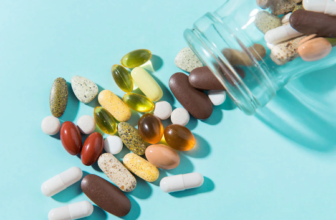Ubidecarenone also called coenzyme Q10, is a 1,4-benzoquinone. From his name (Q10), the Q refers to the constitutive quinone group, and 10 is related to the number of isoprenyl subunits in its tail. It is a powerful antioxidant, a lipid-soluble and an essential cofactor in mitochondrial oxidative phosphorylation.[rx] The ubidecarenone is the coenzyme destined for mitochondrial enzyme complexes involved in oxidative phosphorylation in the production of ATP. It is fundamental for cells that have a high metabolic demand.[rx] Ubidecarenone is sold as a dietary supplement and is not FDA approved as a drug thus, it is not meant to treat, cure or prevent any disease. FDA does not approve these dietary supplements before sold nor regulate the manufacturing process.[rx]
Coenzyme Q, also known as ubiquinone, is a coenzyme family that is ubiquitous in animals and most bacteria (hence the name ubiquinone). In humans, the most common form is Coenzyme Q10 or ubiquinone-10. CoQ10 is not approved by the U.S. Food and Drug Administration (FDA) for the treatment of any medical condition;[1 however, it is sold as a dietary supplement.
Mechanism of Action
Ubidecarenone is an essential cofactor in the mitochondrial electron transport chain. Its functions are the acceptance of electrons from the complex I and II and this activity is vital for the production of ATP. It acts as a mobile redox agent shuttling electrons and protons in the electron transport chain.[rx] Ubidecarenone also presents antioxidant activity in mitochondria and cellular membranes, protecting against peroxidation of lipid membranes as well as inhibiting the oxidation of LDL-cholesterol.[rx]
Ubidecarenone has roles in many physiological processes including sulfide oxidation, regulation of mitochondrial permeability transition pore and translocation of protons and calcium ions across biological membranes. Studies have shown its beneficial effect in treating cancer, statin myopathy, congestive heart failure and hypertension.
Indications
- The diet supplements containing ubidecarenone are indicated, as stated in the product label, to assist individuals with cardiovascular complaints including congestive heart failure and systolic hypertension. In the product, ubidecarenone is used to increase the cardiac input as well as for the prevention of several other diseases like Parkinson, fibromyalgia, migraine, periodontal disease and diabetes, based on preclinical studies.[rx] It is important to highlight that these products are not FDA approved and it is recommended to use under discretion.
- Migraine
- Essential dietary elements or organic compounds that are required in only small quantities for normal physiologic processes to occur.
- Organic substances that are required in small amounts for maintenance and growth, but which cannot be manufactured by the human body
Specific Function
- Accessory subunit of the mitochondrial membrane respiratory chain NADH dehydrogenase (Complex I), that is believed not to be involved in catalysis. Complex I functions in the transfer of electrons from NADH to the respiratory chain. The immediate electron acceptor for the enzyme is believed to be ubiquinone.
- Flavoprotein (FP) subunit of succinate dehydrogenase (SDH) that is involved in complex II of the mitochondrial electron transport chain and is responsible for transferring electrons from succinate to ubiquinone (coenzyme Q). It can act as a tumor suppressor.
- A transmembrane glycoprotein that is the rate-limiting enzyme in cholesterol biosynthesis as well as in the biosynthesis of nonsterol isoprenoids that are essential for normal cell function including ubiquinone and geranylgeranyl proteins.
- Energy-dependent efflux pump responsible for decreased drug accumulation in multidrug-resistant cells.
- Binds LDL, the major cholesterol-carrying lipoprotein of plasma, and transports it into cells by endocytosis. In order to be internalized, the receptor-ligand complexes must first cluster into clathrin-coated pits. (Microbial infection) Acts as a receptor for the hepatitis C virus in hepatocytes, but not through direct interaction with viral proteins (PubMed:10535997, PubMed:12615904). Acts as a receptor for vesicular stomatitis virus (PubMed:23589850). In the case of HIV-1 infection, it may function as a receptor for extracellular Tat in neurons, mediating its internalization in uninfected cells (PubMed:11100124).
- Binds VLDL and transports it into cells by endocytosis. In order to be internalized, the receptor-ligand complexes must first cluster into clathrin-coated pits. Binding to Reelin induces tyrosine phosphorylation of Dab1 and modulation of Tau phosphorylation (By similarity).
Contraindications
Absolute contraindications have not been identified.
- low blood pressure
- liver problems
- blockage of a bile duct
Allergies
- Vitamin E Analogues
- Omega-3(N-3)Polyunsaturated Fatty Acids
- Ubidecarenone (Coenzyme Q10)
Dosage of
Strengths: 60 mg; 100 mg; 200 mg; 30 mg; 50 mg; 400 mg; 30 mg/5 mL; 10 mg; 30 mg/mL; 10 mg/mL; 90 mg/mL; 100 mg/mL; 90 mg; 300 mg.
Dietary Supplement
Oral: 30 to 200 mg/day
Side Effects
The Most Common
- Stomach upset
- Decreased appetite
- Diarrhea
- Increased levels of liver enzymes in the blood
- Nausea
Common
- Allergies
- Low blood pressure
- very low blood pressure–dizziness, severe weakness, feeling like you might pass out.
Rare
- upset stomach, nausea, vomiting, loss of appetite;
- diarrhea;
- skin rash; or
- low blood pressure.
Drug Interactions
- anisindione
- dicumarol
- warfarin
- Alendronic acid
- Atorvastatin
- Anagliptin
- Alogliptin
- Baclofen
- Canagliflozin
- Captopril
Pregnancy Category
Information regarding safety and efficacy in pregnancy and lactation is lacking.
References
- https://clinicaltrials.gov/ct2/about-site/terms-conditions#Usehttps://clinicaltrials.gov/
- https://www.ncbi.nlm.nih.gov/mesh/68014451https://www.ncbi.nlm.nih.gov/mesh/67024989http://www.nlm.nih.gov/mesh/meshhome.htmlhttps://www.ncbi.nlm.nih.gov/mesh/68018977https://www.ncbi.nlm.nih.gov/mesh/68014815
- https://pubchem.ncbi.nlm.nih.gov
- https://www.whocc.no/atc_ddd_index/
- https://www.drugbank.ca/drugs/DB09270
- https://pubchem.ncbi.nlm.nih.gov/compound/Coenzyme-Q10
- https://pubchem.ncbi.nlm.nih.gov/substance/310265165
- https://en.wikipedia.org/wiki/Coenzyme_Q10
- https://www.drugs.com/international/ubidecarenone.html
- https://www.drugs.com/npp/ubiquinone.html
- https://www.medicinenet.com/coenzyme_q10_ubiquinone_ubidecarenone-oral/article.htm
- https://www.webmd.com/drugs/2/drug-77955/ubidecarenone









